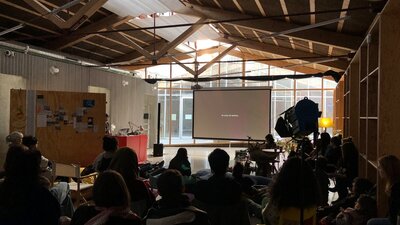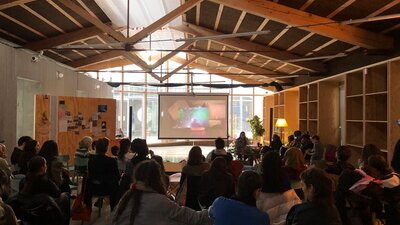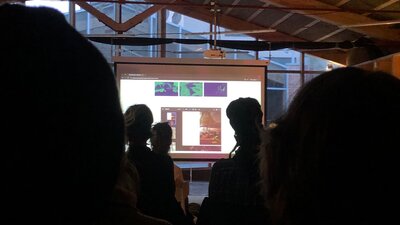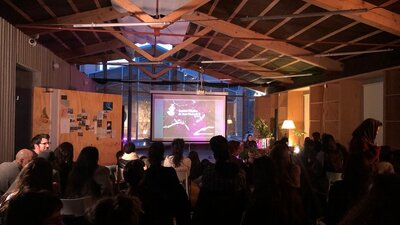
Limited spots available. Prior registration required via this form.
There will be a lunch break from 1:30 p.m. to 4 p.m.
Poster design by Helga Juárez
esto también pasará
encounters on finitude
Esto también pasará is a space of intersection between art, thought, and experimentation around the cyclicality of life and death. From memory to decomposition, from the collective to the microbial, it seeks to open a place to imagine other forms of relationship with the end of bodies, bonds, and worlds.
Driven by the collective DU-DA in collaboration with Mar Sureda and co-curated with Fernando Gandasegui, this event proposes an open gathering where the projects selected through the public call will be presented. The program also includes the participation of Inés Plasencia, who will lead the laboratory “Ficciones para después de una vida” on November 28.
Participants: Patricio Ruiz · Taxio Ardanaz · Orne Cabrita · Álvaro del Fresno & Blanca Ulloa · Andi Icaza-Largaespada · Laura Aurelia Moreno · Marta Nieto · Pablo Zamorano · Clara Silvina · Alma María · Rocío Gómez & Andrea Galano Toro · Karla Hiraldo Voleau · Pedro Gustavo Jiménez Herrera · Elena Sanmartín Hernández · Florencia Toro · Susana Martínez Bacilio
The 2025 edition is an invitation to reflect on our ways of saying goodbye, our rituals, and attachments. It also invites us to question how we care for bodies and their environments in a time of profound unrest: environmental, health, and social crises that confront us with our own humanity and with the limits of life and the planet. If techno-fascism and transhumanist narratives promote the denial of bodily and earthly limits, promising digital eternity and aspiring to avoid death, we propose instead to embrace our fragility, interdependence, and finitude as an essential part of who we are—an act of resistance.
Death is a radically ecological and deeply political matter. We are, by definition, mortal beings: our bodies form part of a continuous material process of recycling. To accept the body is to accept death, and with it, nature itself, of which we are part.
But not all deaths weigh the same, nor do they occur under the same conditions. As we write these lines, the infamy of the genocides in Palestine, the Democratic Republic of Congo, and Sudan continues, while Europe’s liberal necropolitics—through its borders, migration laws, and systems of exclusion—decide daily who lives and who dies. In this context, to speak of death through art also means to take a stand against the mechanisms that produce avoidable deaths and disposable lives, and to search—through the symbolic, the material, and the collective—for ways of resistance, care, and repair.
program
morning
11h a 12:30h - Poetics, fictions, and disorientations of mourning
- Inés Plasencia - Ficciones para después de una vida
- Andi Icaza-Largaespada - grieve sounds like breathe sounds like: Fuego
- Alma María - Inventar un funeral
- Elena Sanmartín - Un paseo sosteniendo un cuerpo y un deseo
- Pedro Gustavo Jiménez Herrera - Índice del infinito
12:45h a 13:30 - Taxio Ardanaz - Eyes (ojos)
— Lunch break from 1:30 p.m. to 4 p.m. —
afternoon
16h a 18h - Undisciplined investigations into finitude
- Rocío Gómez & Andrea Galano Toro - Gestos para remembrar: grieta, mancha, ceniza
- Clara Silvina - Sueños Frágiles de Auto Plateado
- Karla Hiraldo Voleau - Forget Me / Forgive You
- Pablo Zamorano - El Primer Tacto
- Laura Aurelia Moreno - Cuidar, orar y enterrar: Los Hermanos Fosores de la Misericordia
- Marta Nieto - Ahora cuido viña
— Break —
18:30h - Orne Cabrita - ¿Cómo cerrar los ojos y que no me importe morir?
19:30h - Álvaro del Fresno y Blanca Ulloa - La Primera como Farsa, La Segunda como Tragedia
20:30h - Patricio Ruiz - Guacha
exhibition projects
- Florencia Toro - Espectro Visible
- Susana Martínez Bacilio - Tejiendo para la eternidad
project bios
Patricio Ruiz — Guacha
A performative and visual diary that explores death, migration, and identity as processes of transformation and border. Following the loss of his parents to COVID-19, Patricio interlaces poetry, ritual, documentary, and performance to address orphanhood and queer becoming. The work invites a participatory space where voices and bodies intertwine, tracing a poetics of grief and resilience.
Taxio Ardanaz — Eyes (ojos)
Eyes begins with a poem found in the jacket of a brigadista killed in the Spanish Civil War, delving into the emancipatory power of images. Through a visual archive of anonymous inscriptions, drawings, and marks made during and after the war, Ardanaz explores how creation can resist destruction and oblivion. The project unfolds as a performative and visual reading that reflects on memory, fragility, and the power of art in the face of death.
Orne Cabrita — ¿Cómo cerrar los ojos y que no me importe morir?
A performative proposal that reflects on migratory grief, absence, and finitude from a Caribbean perspective. Through a performative installation combining orality, family memory, and spiritual rituals, Cabrita explores the continuity between life and death and the right to farewell as a form of resistance against exile.
Álvaro del Fresno & Blanca Ulloa — La Primera como Farsa, La Segunda como Tragedia
A performative and choreographic project exploring the relationship between history, repetition, and death through a dialogue between two figures—the ephemeral angel and the angel of repetition—reflecting on temporality, subjectivity, and the possibility of rupture amid the reiteration of the present.
Karla Hiraldo Voleau — Forget Me / Forgive You
This project explores whether forgetting can be a voluntary and emancipatory act in the face of traumatic memories born from emotional violence. Inspired by Eternal Sunshine of the Spotless Mind (Michel Gondry, 2004), it transposes its speculative clinic into real life, turning the author’s own biography into a testing ground. Through performance, photography, writing, interviews, and a feminist framework, it investigates how to forgive and forget in times when the digital renders erasure nearly impossible.
Alma María — Inventar un funeral
After experiencing three perinatal losses, Alma María proposes to collectivize her own grieving process by inviting others to imagine funerals for these invisible losses. Following the classic structure of a rite of passage, the project invites a public farewell to whatever each person needs to let go of, reclaiming the communal power of burial as a healing act.
Laura Aurelia — Cuidar, orar y enterrar: Los Hermanos Fossores de la Misericordia
An ethnographic and photographic investigation of the world’s only Catholic community devoted exclusively to burying the dead. Based in Guadix, the Brothers Fossores embody a life lived on the threshold between the living and the dead, where care becomes an act of resistance against the contemporary commodification and concealment of death—while bearing the social stigma of inhabiting the taboo.
Pedro Jiménez Herrera — Índice del infinito
An audiovisual and performative project reflecting on decomposition, residual heat, and transition through a dialogue with cassava—a tuber native to the Amazon and Andes—and with the ghosts of a farmer father and a cook friend. The cutting or stem (“esqueje”) becomes a form of breath, between the vegetal and the spectral.
Pablo Zamorano — El Primer Tacto
An interdisciplinary investigation interweaving mediumship, performativity, and philosophy to explore the relationship between life and death through the invisible and the impermanent. Through a “perfo-conference,” the project examines how bodies become channels for what is no longer here, offering an experience between the sensorial and the spiritual.
Elena Sanmartín — Un paseo sosteniendo un cuerpo y un deseo
Emerging from a grief shaped by homophobia and suicide, this artistic research and mediation process proposes to imagine collective rituals for holding pain. The act of walking becomes a political and affective gesture, allowing one to inhabit loss from a situated and shared place.
Marta Nieto Postigo — Ahora cuido viña
Based on the prolonged care of vineyards abandoned by industrial logic, this project testifies to living with the more-than-human beyond productivity. Through drawings, voice notes, and experimental wine, the artist shares sensitive learnings about the life cycle, gratitude, and repair in times of collapse.
Rocío Gómez & Andrea Galano — gestos para remembrar: grieta, mancha, ceniza
Video essay on the study process that investigates deterioration from a material, conceptual, and linguistic perspectives. Through three case studies—crack, stain, and ash—it explores their cycles and poetic resonances through territorial, political, and ecofeminist lenses, revealing their spectral and unsettling dimensions.
Clara Silvina — Sueños Frágiles de Auto Plateado
Artistic research on how to accompany the disappearance of bodies and landscapes, and imagine farewell rituals. Inspired by Derrida and Celan, Clara conceives trembling as a pulse that runs through her practice: a surrender to the unpredictable, a way of accompanying what dies without trying to fix it. Death as a loss of speed and as a force that links vulnerability.
Andi Icaza-Largaespada — grieve sounds like breathe sounds like: Fuego
Multidisciplinary research that proposes queer (dis)orientations to grief, bodily memory, situated matter, and legacies of resistance, turned into a physical warm-up exercise. It brings together an expanded archive of gestures and voices—including that of her father's last machete—to the fire in mourning to transmute losses and displacements into more dignified experience.
Florencia Toro — Espectro Visible
Using rose petals recovered from the floral waste of the Montjuïc crematorium, the artist investigates pigment extraction and bacterial proliferation to reveal the chromatic spectrum of transformation. Color becomes a material testimony of that which dies to become something else.
Susana Martínez Bacilio — Tejiendo para la eternidad
Inspired by Mochica myths, this project approaches the backstrap loom as a metaphor for life and death. The weaving, tensioned from the womb, symbolizes gestational time and the continuity between the lived and the ancestral. When the loom is released, the end is revealed as a passage toward the whole.
If you have any needs or questions regarding the accessibility of this activity, please, visit the page "access La Escocesa" by clicking here

Limited spots available. Prior registration required via this form.
There will be a lunch break from 1:30 p.m. to 4 p.m.
Poster design by Helga Juárez



